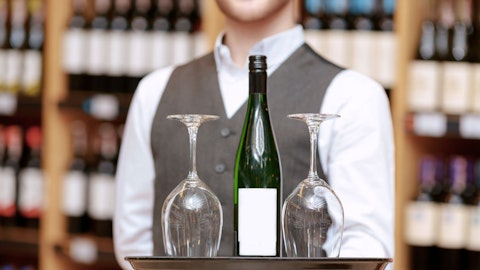Now I think the European markets might take a little bit longer to recover at least in some of the different categories of the longer, value chain categories overall.
Andres Lopez: And I think that the key segment we got to follow, or track closely is the wine segment in France. That is really where the largest slowdown is at this point in time. So as we continue to update, we will look at that more specific.
Arun Viswanathan: Great. Thanks. And then as a follow-up, I was very – I was hoping to ask about your energy hedges, apologies if I missed this earlier, but could you just update how we think about price versus, you know, energy costs, over a similar range, maybe the next 12 to 18-months in what you are doing to maybe roll out or extend some of those hedges? Thanks.
John Haudrich: Yes, sure. For clarity, we take a three year view minimum on our energy contracting position. So as we stand here right now, today, you know, we have contracted substantially through 2025, for example. And those were done at very favorable rates as we mentioned in the past, you know, more indicative of rates before, the pandemic or before the Ukraine War. So, those rates are favorable. What we had seen is, you know, energy, if you look at just TTF over in Europe, which is probably the most dynamic one, rates were, you know, coming down to, you know, they were over 50 Euros per megawatt hour. They dropped down into the thirties here more recently. But frankly, with the advent of the Israeli Hamas conflict, we have seen things jump back up to 50 again.
And if you look at the forward curves, they stay in the 50s over through 2025, and then start to tail off in 2026. So even though, the, you know, the spot markets are very, are elevated in energy, probably two, two and a half times what our contracted at, you know, we aren’t exposed to that level of variability.
Operator: Thank you. Our next question, goes to Gabe Hadji of Wells Fargo Securities. Gabe, please go ahead. Your line is open.
Gabe Hadji: Thank you. Andres, John, Chris, good morning. I wanted to maybe, I guess to ask or carry on to that talking point there, John, in terms of cost competitiveness of glass, appreciating that, you know, filling can’t be switched overnight, these things take investment. Any thoughts, indoor visibility, either, you know, based on order patterns or anything like that that you can offer up in terms of, more on the beer side, I’m thinking, you know, potential for substrate shift in any of your markets. And in response to that, you know, potential, you know, internally you are planning for, if some of those orders don’t necessarily come back your ability to kind of close those plants and the curtailments that you are talking about, are those sort of warm still the furnaces or have you taken any cold shots at this point?
Andres Lopez: So the competitiveness of glass, this was other packaging in particular aluminum can, is back to pre-pandemic levels. So during the last few years that gap closed a little bit, and it went back to where it was back in 2019. Now you might have heard the — some growth in some regions or markets for aluminum cans. And when we look at that remember that we mentioned before that glass and aluminum cans play in different lanes and the type of products that drive the growth in cans are products in which we are not present. So I think It is important to highlight that. When we look at share, we haven’t seen that much chair shift minimum really, and It is primarily driven by down trading or promotions, and we consider those to be temporary.
John Haudrich: Yes. I think even on that last point is you can even see that specifically in the Nielsen data. You look at the volume trends and consumer consumption trends, we can see what the overall trends, we can see how that the products are being consumed in glass containers and aluminum cans, for example and everything’s within like a percent or so of each other. I mean, given the level of variation that we are seeing out there, It is all within a relevant range. So yes, maybe there is a little bit of downshifting a little bit going on there, but it is not a material difference given the scale of the change that we are seeing out there. On the furnace position you asked, we are taking those cold. So for example, [Waco] (Ph) is closing, so it will be a cold furnace and not operating anymore.
Gabe Hadji: Okay. I’m appreciating that you guys operate in relatively different markets than some of your peers, and I’m more specifically thinking about Europe, but just there is been a lot of volatility in that market in the past four years. And I’m just curious again, you pointed out elevated conflict in the Middle East and rising energy costs. Are you hearing anything from the competitive landscape that some of these smaller folks may not be able to react or have the financial wherewithal withstand another shock to the system? And is that a consideration in some of the discussions that you are having with your customers? And then there was also a recent, I think, change of control for one of your peers in Europe. Again, to the extent you can comment anything in terms of competitive landscape that you’d expect to be different there.
John Haudrich: Yes, It is hard to read through to all the competition. I mean, they have to report on their own positions, but when we saw the energy prices, for example, in Europe go up last year, you saw the smaller competitors who typically don’t have a sophisticated energy management position going offline. So if in the event that there is more escalation and more of an energy shock than I suspect that there is an exposure there for them, obviously in the discussions with our customers, continuity of supply has always been important. We saw that last year in particular. And I think we did quite well in that regard. We were able to be a solid supplier for our customers out there. And as you take a look at it right now, we are taking, as I mentioned before, 20% curtailment out there to balance off inventories. Clearly, you can research it on your own, but if you take a look at other public information, it seems to be a consistent practice across the marketplace.
Operator: Thank you. Our next question goes to Roger Schmitz of Bank of America. Roger please go ahead, your line is open.
Roger Schmitz: How much of your inventory your customers typically hold? Say in days or weeks? Where we were at the beginning of the year and where we might be at the end of the year in rough numbers?
Andres Lopez: Yes, so I think, when we look at the stocking, the stocking is influenced not just by the inventories of customers, but It is distributors, these wholesalers, these retailers, and It is even consumers depending on what the supply chain we are talking about. So for us, the way to look at this is short supply chains will recover faster and we are starting to see some early signs of that in some markets and long supply chains will take longer. So the short supply chain should recover as we exit this quarter or normalize as we exit this quarter and the long one as we exit the first quarter of 2024.




